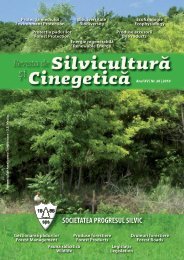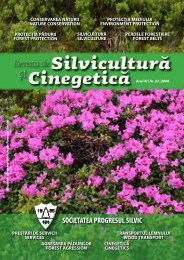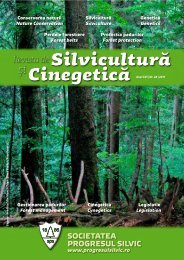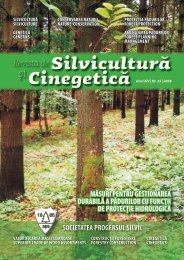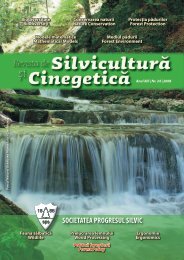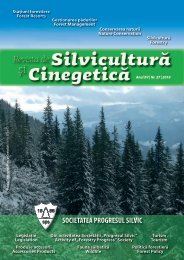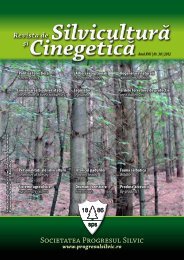Silviculture and Cinegetics Review - Societatea Progresul Silvic
Silviculture and Cinegetics Review - Societatea Progresul Silvic
Silviculture and Cinegetics Review - Societatea Progresul Silvic
Create successful ePaper yourself
Turn your PDF publications into a flip-book with our unique Google optimized e-Paper software.
EDITORIAL SILVICULTURES AND CINEGETICS REVIEW XVII/30/2012<br />
Scientific Foundation for Creating Field Protection Forest Belts in the<br />
Banat Plain<br />
1. Introduction<br />
In the current conditions of reduction of the forest<br />
area <strong>and</strong> climate aridity (with trends of desertification<br />
in some areas), the field protection forest belts are<br />
again of interest in Romania. Their advantages are<br />
multiple. Among them we can list the following: wind<br />
speed slow down, with direct implications:<br />
evapotranspiration reduction; windblown snow<br />
accumulation; soil erosion reduction; crop damage<br />
reduction; agricultural production increase; local<br />
environment improvement; an additional contribution<br />
of wood to rural population; irrigation cost reduction;<br />
improvement of the habitat for game <strong>and</strong> birds useful<br />
to agriculture; l<strong>and</strong>scape embellishment.<br />
In our country, a favorable opinion towards the field<br />
protection belts was emerging after the droughts<br />
1928-1929 <strong>and</strong> 1933-1935, when the first plantations<br />
in Bărăgan (Neşu 1999) started. Up to the l<strong>and</strong> reform<br />
in 1945 there were created about 1100 ha of isolated<br />
forest belts, spread throughout the country.<br />
Nevertheless, their installation was made without<br />
having a systematic study as their basis.<br />
During the period 1943-1957 in the radius of ICAS<br />
Bărăgan, I.C.A.R. Mărculeşti <strong>and</strong> Mărculeşti<br />
Township there were created more consistent<br />
networks of forest belts. Subsequent preservation of<br />
these cultures was very limited (the same as in the<br />
case of forest belts created in certain areas of the<br />
Banat Plain), the majority of them having been<br />
deforested. The Bărăgan Forestry Experimental<br />
Station had as main objective the experimentation in<br />
the domain creation of field protection forest belts.<br />
The interest in installing field protection forest belts<br />
has increased significantly in recent years in Romania<br />
as well. The people has begun to realize their<br />
beneficial role, so many municipalities in Banat have<br />
started the installation of forest belts. Research on the<br />
beneficial role of field protection forest belts were<br />
made over time in different countries. Almost<br />
unanimously it was found that field protection forest<br />
belts create a good environment for crop development<br />
in the protected areas, therefore obtaining a crop<br />
growth compared with agricultural cultures in open<br />
field.<br />
In different countries the effect of the field protection<br />
Ioan Adam, Nicolae Cadar, Oliver Merce, Ilie Cântar<br />
.<br />
forest belts on different crops was studied, according<br />
to their interest, as follows: Germany (rye, wheat,<br />
barley, oats, potatoes, sugar beets, cabbage etc.),<br />
United States (wheat, corn, alfalfa, <strong>and</strong> cotton),<br />
Canada (wheat, corn), Hungary (wheat, strawberries),<br />
The Netherl<strong>and</strong>s (apples, pears, <strong>and</strong> rye), Czech<br />
Republic (wheat), Russia (rye, wheat, barley). In<br />
Canada such research were made over a period of 100<br />
years, their results being published in professional<br />
journals (Droze 1977, Easterling et al. 1997,<br />
Anonymous 2008).<br />
Other research focused on the effect of reducing wind<br />
speed by installing forest belts, such as those<br />
conducted in Russia (N.P. Adamov, A, Batsiev),<br />
Hungary (G. Marczel), Switzerl<strong>and</strong> (W. Nageli), <strong>and</strong><br />
Germany (Blenk). Studies that targeted modification<br />
of air temperature near the forest belt (Mitschelich /<br />
Germany, Van Eimern / The Netherl<strong>and</strong>s), soil<br />
temperature (Jensen <strong>and</strong> Aslyng – Norway,<br />
V<strong>and</strong>erberg / Russia) were also carried out.<br />
Certain countries (Canada, United States) have<br />
created centers that promote <strong>and</strong> offer technical<br />
assistance for the installation of field protection forest<br />
belts (Anonymous 1997, 2011, Br<strong>and</strong>le et al. 2000).<br />
2. Method<br />
In order to develop the paper, during the first stage<br />
there were collected a large number of data: climate<br />
(weather stations), water (Romanian Waters), soil<br />
(O.S.P.A. – Soil <strong>and</strong> Agrochemical Studies Office)<br />
<strong>and</strong> vegetation (D.S. Timiş, D.S. Caraş Severin,<br />
Agricultural University of Banat), <strong>and</strong> data from<br />
A.N.I.F. (National Agency for L<strong>and</strong> Development).<br />
Some aspects of these data were checked in the field.<br />
The Banat Plain is considered sub-humid zone. In<br />
order to determine the area of more accentuated<br />
drought specific to the Hungarian dry-plains, the<br />
drought index was calculated using three methods:<br />
1). The P.A.I. (Palfai Aridity Index) is a drought<br />
index used in the Pannonian Plain (Man 2007). The<br />
P.A.I. is obtained by multiplying the index P.A.I. 0<br />
with:<br />
- temperature correction coefficient;<br />
14



